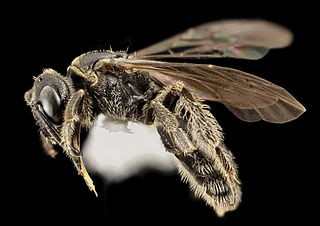
The Ichneumonidae, also known as the ichneumon wasps or ichneumonids, is a parasitoid wasp family within the insect order Hymenoptera. This insect family is among the most species-rich branches of the tree of life. At the same time, it is one of the groups for which our knowledge most severely lags behind their actual diversity. The roughly 25,000 species described today probably represent less than a quarter of their true richness, but reliable estimates are lacking, as is much of the most basic knowledge about their ecology, distribution and evolution. Ichneumonid wasps, with very few exceptions, attack the immature stages of holometabolous insects and spiders, eventually killing their hosts. They thus fulfill an important role as regulators of insect populations, both in natural and semi-natural systems, making them promising agents for biological control.

Platygaster is a genus of parasitoid wasps in the family Platygastridae. There are more than 560 described species in Platygaster.
Anteris is a genus of wasps in the family Platygastridae. There are about 15 described species in Anteris.

Paramormyrops hopkinsi (Taverne and Thys van den Audenaerde, 1985) is a species of freshwater electric fish. It was discovered in the Ivindo River in Gabon, in west-Central Africa by Dr. Carl D. Hopkins of Cornell University. It is distributed throughout the Ivindo River basin of Gabon and the Ntem River basin of Cameroon. Described originally as a Brienomyrus in 1985 it was transferred to Paramormyrops in 2007. The electric discharge has two phases: a head-positive phase followed by a head-negative phase. The mean duration of the EOD is 2.8 ms for females, 2.96 for males. The Fourier transform of the EOD peaks at 536 Hz for females, 468 for males. Both male and female EODs have a head-negative voltage bump about 5 to 6 ms after the main head positive phase (arrows).

The Christmas darter i is a species of ray-finned fish, a darter from the subfamily Etheostomatinae, part of the family Percidae which includes the perches, ruffes and pike-perches. It is found in the Savannah, Ogeechee and Altamaha catchment areas in South Carolina and Georgia. It is a small but colorful fish, typically less than 5 cm (2 in) in total length, with blackish, red and green streaks on its flanks. Green and red are associated with Christmas, hence the common name Christmas darter. Like other darters, it lives on or close to the stream-bed, in riffles and vegetation-laden stretches of small rivers, creeks and spring-fed streams. It feeds on aquatic insects and probably breeds in the spring, but its biology and behavior are poorly known.
Oethecoctonus oecanthi is a species of parasitoid wasp in the family Platygastridae.
Synopeas is a genus of parasitoid wasps in the family Platygastridae. There are more than 250 described species in Synopeas.
Oethecoctonus is a genus of parasitoid wasps in the family Platygastridae. There are about six described species in Oethecoctonus.
Teleasinae is a subfamily of wasps in the family Platygastridae. There are about 14 genera and more than 250 species in Teleasinae.
Platygaster rubi is a species of parasitoid wasp in the family Platygastridae.

Pseudopanurgus is a genus of mining bees in the family Andrenidae. There are at least 130 described species in Pseudopanurgus. Pseudopanurgus bees often have 2 submarginal cells in their forewings. Their size range for extra-small to small, 3mm to 10mm
Metaclisis floridana is a species of parasitoid wasp in the family Platygastridae.
Macroteleia carinata is a species of parasitoid wasp in the family Platygastridae.

Macroteleia is a genus of parasitoid wasps in the family Platygastridae. There are more than 140 described species in Macroteleia.
Scelio floridanus is a species of parasitoid wasp in the family Platygastridae.
Pityogenes hopkinsi, the chestnut-brown bark beetle, is a species of typical bark beetle in the family Curculionidae. It is found in North America.
Platygaster munita is a species of parasitoid wasp in the family Platygastridae. It is found in Europe.
Trichacis virginiensis is a species of parasitoid wasp in the family Platygastridae.
Neuroctenus hopkinsi is a species of flat bug in the family Aradidae. It is found in North America.

Callirhytis is a genus of gall wasps in the family Cynipidae. There are more than 90 described species in Callirhytis.






